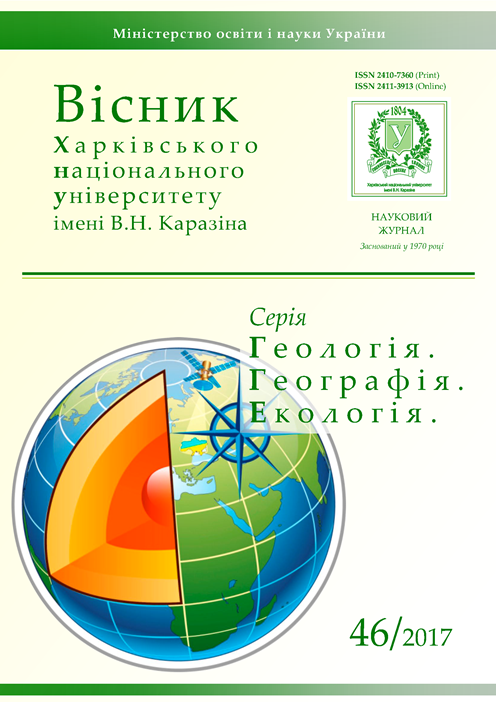Про зв’язок сучасних геодинамічних процесів у карбонатних породах з тектонічною активізацією Петрівсько-Кремінського розлому
Анотація
Розглянуто зв’язок сучасних геодинамічних процесів у карбонатних породах з тектонічною активізацією Петрівсько-Кремінського розлому. Наголошено, що глибинні розломи регіону є каналами висхідного руху потоків тепломасоперенесення. Розвантаження вод глибокого формування та ендогенних флюїдів у зоні Петрівсько-Кремінського та інших розломів є наслідком тепломасоперенесення, що відбувається через рухи літосферних блоків Донецької складчастої споруди.
Сучасний напружений динамічний стан геологічної системи проявляється у постійному здійманні висячого крила Святогірської брахіантикліналі зі швидкістю 1,3-2,5 мм/рік. Землетруси з глибиною вогнища ~10 км пов’язані з періодичною релаксацією геодинамічних напруг у архей-протерозойському комплексі фундаменту по древньому геологічно закритому субмеридіональному розлому, що перетинається у межах Святогірської структури з Петрівсько-Кремінським розломом. Новітньо-сучасна тектонічна активізація останнього проявляється і у формуванні гіпогенних гідрогеохімічних аномалій, що супроводжується гідрогеохімічною інверсією. Підземні води тут мають лужну реакцію (pH до 8,2), підвищену температуру (19-27 ºС) в інтервалі 0-300 м та високі вмісти гіпогенних мікроелементів, серед яких особливе місце займає двооксид вуглецю.
Присутність СО2 збільшує агресивність підземних вод щодо карбонатних порід, наслідком чого є такий хімічний геодинамічний процес, як карст. Окрім того, аномальні фізико-хімічні властивості підземних вод обумовлюють і суфозійні процеси у мергельно-крейдяній товщі порід. З цими геодинамічними процесами пов’язані геологічні ризики для будівель та споруд Святогірського монастиря.
Завантаження
Посилання
2. Белоконь В. Г. О глубинном источнике энергии углеобразования формации Донецкого бассейна / В. Г. Бело-конь // Геологический журнал. – 1981. – Т. 41, № 6. – С. 88–99.
3. Белоконь В. Г. Бассейн р. Северский Донец как геодинамическая система, отражающая процессы больших глубин / В. Г. Белоконь // Геологический журнал. – 1984. – Т. 34. – Вып. 5. – С. 11–27.
4. Бескровный Н. С. Изотопный состав углерода природных газов Камчатки / Н. С. Бескровный, Е. И. Кудряв-цева, В. А. Лобков // Геохимия. – 1975. – № 11. – С. 1660–1667.
5. Гаррелс Р. М. Растворы, минералы, равновесия / Р. М. Гаррелс, Ч. Л. Крайст. – М. : Мир, 1968. – 368 с.
6. Дегенс Э. Т. Биогеохимия устойчивых изотопов углерода / Э. Т. Дегенс. – В кн. : Органическая геохимия. – Л., 1974. – С. 207–226.
7. Калюжный В. А. Современное состояние проблемы «Углерод и его соединения в эндогенных процессах мине-ралообразования (по включениям в минералах) / В. А. Калюжный // В сб. «Углерод и его соединения в эндо-генных процессах минералообразования (по данным изучения флюидных включений в минералах»)». – К. : Наукова думка, 1978. – С. 3–16.
8. Киссин И. Г. К геохимии углекислоты в глубоких зонах подземной гидросферы / И. Г. Киссин, С. И. Пахомов // Геохимия. – 1969. – № 4. – С. 460–471.
9. Конашов В. Г. Мезозойский этап тектогенеза в Донецком бассейне / В. Г. Конашов // Геологический журнал. – 1983. – № 3. – С. 96–102.
10. Лазаренко Е. К. Минералогия Донецкого бассейна / Е. К. Лазаренко, Б. С. Панов, В. И. Павлишин. – К. : Нау-кова думка, 1975. – Ч. ІІ. – 502 с.
11. Лущик А. В. Формирование режима подземных вод в районах развития активных геодинамических процес-сов / А. В. Лущик, Г. В. Лисиченко, Е. О. Яковлев. – К. : Наукова думка. – 1988. – 164 с.
12. Мейсон Б. Основы геохимии / Б. Мейсон. – М. : Недра, 1971. – 312 с.
13. Набоко С. И. Металлоносность современных гидротерм в областях тектономагматической активизации / С. И. Набоко. – М. : Наука, 1980. – 199 с.
14. Національний атлас України. – К. : ДНВЦ «Картографія», 2009. – 440 с.
15. Скаржинский В. И. Эндогенная металлогения Донбасса / В. И. Скаржинский. – К. : Наукова думка, 1973. – 203 с.
16. Соколов Д. С. Основные условия развития карста / Д. С. Соколов. – М.: Госгеолтехиздат, 1962. – 321 с.
17. Сухов В. В. О результатах экспериментов по изучению влияния процессов замерзания и таяния капиллярных и трещинных вод на горные породы / В. В. Сухов // Матеріали наук.-практ. конф. «Регіон – 2012. Стратегія оптимального розвитку». – Харків, 2012. – С. 309-312.
18. Сухов В. В. Гідрогеологічні особливості карбонатного карсту / В. В. Сухов, В. Г. Суярко, О. О. Сердюкова // Science Rise. – 2015. – № 7/1(12). – С. 23-27.
19. Суярко А. В. Роль зон разгрузки глубинных вод в выяснении природы геотермических аномалий и рудной ми-нерализации в Западном Донбассе / А. В. Суярко // ІІ геол. конференция «Степановские чтения». – Арте-мовск, 1968. – С. 161–163.
20. Суярко В. Г. Особенности формирования вертикальной гидрогеохимической зональности в мезозойских структурах Донецкого прогиба / В. Г. Суярко // Геологический журнал. – 1984. – Т. 44, № 1. – С. 127–130.
21. Суярко В. Г. Геохимия подземных вод восточной части Днепровско-Донецкого авлакогена / В. Г. Суярко. – Харьков : ХНУ имени В. Н. Каразина, 2006. – 225 с.
22. Суярко В. Г. Концептуальна синергетична геолого-гідрогеологічна модель розвитку суфозії та карсту у кар-бонатних породах на території Святогірського монастиря / В. Г. Суярко, В. В. Сухов // Вісник ХНУ імені В. Н. Каразіна, серія «Геологія. Географія. Екологія». – 2015. – № 1157. – С. 63-68.
23. Филькин В. А. Опыт составления карты современных движений земной коры по территории Донбасса / В. А. Филькин // Современные движения земной коры. – К. : Наукова думка, 1986. – С. 216–221.
24. Fournier F. Climatel erosion / F. Fournier. – Press Universitaries de France. – Paris, 1960. – 120 p.
25. Sukhov Valeriy. Forecast of potential natural risks for the historical and architectural sights of the Holy Mountains Lavra (Sviatohirsk Monastery) / Valeriy Sukhov // Young Scientist USA. – Vol. 4. – Lulu, USA. – 2015. – P. 126-130.
26. Wiebe R. The solubility of carbon dioxide in water at various temperature from 12 to 40o and at pressures to 500 atmospheres / R. Wiebe, V. L. Gaddy // Critical phenomena, J. Am. Ckem. Soc., 62, 1940. – Р. 815–817.





